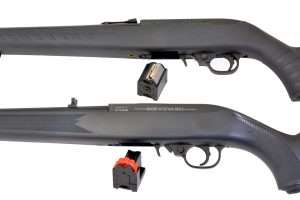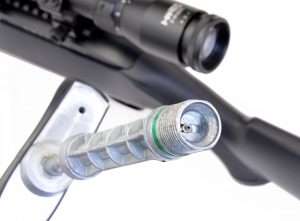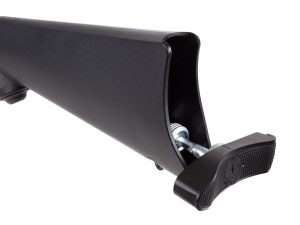Scoped & Ready for the 10-meter Range

Pellet rifles fall into a number of categories from Olympic competition to small game hunting and just plain old plinking and target shooting. The best pellet rifles are usually expensive (or comparatively expensive) precharged pneumatics (PCP), premium underlever spring air rifles, like the RWS Diana 460 Magnum, spring piston break barrels, like the Beeman R7 Elite Series, while at the lower end of the price spectrum are CO2 powered air rifles using an 88 gr. CO2 cartridge or dual 12 gr. CO2 cartridges. The Ruger 10/22 falls into the last category and with its sealed air chamber in the buttstock has enough power to send 4.5mm pellets downrange at velocities capable of being effective for small varmint hunting and practical target shooting, both of which are greatly enhanced with the use of a variable power scope like the Mantis. Pyramyd AIR has picked a good match for the Ruger 10/22 in the Rifle Kit.

Recapping the 10/22
Using the same internal design as the Umarex Cowboy Lever Action model means you have two 12 gr. cartridges supplying CO2 to the rifle. Umarex recommends a drop of RWS Chamber Lube on the tip of each cartridge as it is inserted as well as the O-ring on the piercing screw, which I recommend with this rifle; a good seal is everything with this system. Once you turn down the piercing screw, the forward-facing CO2 is pierced by a pin in the front of the chamber and the rear-facing cartridge is pierced by the seating screw that shrouds the front of the second cartridge. When the seating screw is turned down until it stops, all of the air from both cartridges is released inside the chamber, which is sealed by the large green O-ring on the seating screw. This gives the gun a factory-rated velocity of up to 700 fps. When I did my initial test of the pre-production sample, the Ruger 10/22 was to be rated at 650 fps. So now with a production gun I am going to recap the CO2 loading and then run a chronograph test with the same Meisterkugeln 7.0 gr. lead wadcutters I used with the Umarex sample gun. I am also going to run a test with premium grade RWS R10 Match wadcutters and lightweight Sig Sauer Match Ballistic alloy wadcutters to see what the maximum velocity can average. This is probably where we will see the 700 fps speeds. With the sample gun, alloy wadcutters were clocking around 718 fps.

The 10/22 is a very familiar style of small caliber carbine, as so many semi-auto rimfire and centerfire rifles have been based on William B. Ruger Sr.’s classic 10/22 design from the 1960s. At the heart of the gun is the rotary magazine, which was quite a big deal when it was introduced. It was featured in most of Ruger’s early magazine advertisements. The CO2 model uses on the general magazine design but adds the 10-round rotary pellet magazine at the front. It loads into the receiver the same way as the rimfire mag. The sights are the same, too, and with the rifled barrel, the sample gun had delivered fairly tight groups at 10 meters shooting from a benchrest. With Meisterkugeln, my best 5-shot group from 10 meters measured 0.437 inches in the 9, 10 and X rings with an average velocity of 630 fps. I had also shot the RWS R10 Match and scored a best five rounds at 0.53 inches in the 9, 10 and X rings, with four of five hits overlapping. My expectations for the 10/22 with the Mantis scope at 10 meters, then, are very high!




New Velocity Checks
With this new production gun in hand I loaded the two CO2 cartridges and ran my first velocity test with the Meisterkugeln. Average velocity for 10 shots with 7.0 gr. lead wadcutters was 644 fps with a high of 657 fps and a low of 635 fps. The R10 matched closely at an average of 642 fps and the alloy wadcutters broke the 700 fps line with an average of 708 fps, a high of 722 fps and a low of 699 fps.


For today’s accuracy test, I will be sighting in the scope at 10 meters and shooting from a rest, as well as running a 10 meter test outdoors firing from the shoulder. With the scope mounted and the vertical and horizontal alignment of the crosshairs verified both from the shoulder and benchrest by lining them up on a target and making sure the rifle is perfectly vertical. I had to make one slight adjustment of the scope in the mounts, loosening the screws and rotating the scope about 3 degrees right, to get it perfectly centered. I was ready to sight the scope in for the bench test at 10 meters. I found the best combination was setting the objective to 20 yards, and for my preferences, the power zoom at the rear to 6 (it adjusts from 3X to 9X), and then adjusting the focus ring for my vision. At 10 meters both the reticle and target were sharp. It took a total of 8 shots to get the scope zeroed in on the bullseye, shooting from the rest and cocking the action for each shot.

Downrange Accuracy
Firing from the rest at 10 meters I put 10 shots into the bullseye and 10, all overlapping, with a total spread of 0.5 inches. That would put any five shots inside that spread at 0.25 inches. Scoped and rested, I think that is about as good as I can do. The proof will be in my 10 meter shots fired standing and firing from the shoulder.

That proved a bit more challenging with a slight crosswind and lacking the support of the benchrest. I took a long time to shoot my 10 rounds and again, rather than working the double action trigger, I used the charging handle to cock the action for each shot. The single action trigger pull on this gun was a very light 2.0 pounds, with just a fraction of an inch of take up.


The design of the gun, as I see it, is such that for a blowback action to work and re-cock the action after each shot using the rotary (pellet) magazine, like the rimfire model, would require a more complex (i.e. more expensive) design, and maybe even cost some of the Ruger’s 650 fps average velocity in the bargain. For carefully aimed shots, working the charging handle to cock the action is no more laborious than shooting with a bolt action rifle. My best 10-round target had a spread of 1.1 inches with a best five shots at 0.5 inches, but all hitting left of center and clipping the 8 ring. Fired semi-auto with the double action trigger, which has a pretty heavy pull, accuracy is going to suffer without question, but for my money, shooting with the Mantis scope isn’t about speed, it is about accuracy and the Umarex Ruger 10/22 will give you that with or without optics.


I’ve been shooting ARA Precision Bench Rest 22LR for years, 50yds & Scoped Remington 40X, Custom Rigs as well… I also shoot a couple, Built by me, Ruger 10-22s, so I am knowlegable regards this subject, FWIW…….I believe the Umarex-Ruger 10-22 you are reviewing is an Excellent example of an Inexpensive way to get into Rifle Bench Rest shooting…Compared to CO2 I pay $10 to $16 a box for Eley Match Ammo, 50 bullets. So no comparison for Cost to shoot…I am really impressed with the Scope being offered in the Kit…Umarex-Ruger hit a Homerun with this Rifle, Thanks for Reviewing & looking forward to your 25yd testing…………….Also FWIW my 22LR BR Rigs use a Jewel 4oz Trigger pull, a Brimstone 2lb pull on my 10-22 so the 3lb pull on this CO2 Ruger sounds just right……..So for $200 this is a Win Win CO2 Rifle
Nice shooting. I have found this rifle to be accurate and fairly powerful. Despite the da heavier pull , it is still accurate, in sa mode it is fine. Would have preferred a true semiauto, but fps would probably be in maybe 500 fps range with 7 gr lead pellets.A better platform for semiauto would be a stick Fed co2 bb version of the PC9 . Umarex could offer a Ruger American bolt action pellet rifle with 20 inch barrel using the basic format of the 10/22 rotary mag. As is , the 10/22 is a decent understudy for the 10/22 22 lr. One word of caution is to not keep firing as co2 gets low. You run the risk of a pellet becoming lodged between the mag and chamber, and is s pain to fix. My advice to Umarex is to offer a takedown version of this rifle.
Haven’t tried the Ruger outdoors yet, but Iwill before weather turns cold. Usually bundled scopes are not too good but this package seems like they got it right.
Hi Denis
Please excuse for being so far off topic.
Well, the last few months has seen a couple of new airguns come into my possession.
The first was the Sig Sauer M17. A nicely made pistol and a good shooter with Sig Ballistic Match 5.25 gn Alloy Pellets. This is where the problem begins. It appears that Sig no longer stocks or sells the Ballistic Match Alloy Wadcutters. To me that’s poor, very poor customer support in an indirect sort of way. Those pellets were a reasonable price and at one time easily available. Now the next best are the 7.0gn Meisterkugeln and Hobby wadcutters which need enormous holdovers and in my opinion not worth shooting at 10 to 15 yards which is where I mostly shoot.
Yes, there other alternatives I suppose, like the other brands of alloy pellets that are available but they all seem to run about $25 per 500 ($35 or more per 500 in Canada plus shipping plus brokerage fees which just ain’t going to happen) (I buy .22LR cheaper than those pellets)
Recently I found an online store here in Canada and bought out their whole stock of 14 tins of Sig Ballistic Match Alloy pellets at an excellent price of US $8.00 per tin and free shipping! I don’t think there’s any left in Canada now at a reasonable price!!
When those are gone I may have to start fileing down front sights to make the heavier 7 gn pellets shoot more to POA. Maybe they’ll have their mount and red dot ready by then!
Shame on Sig!!
The second gun this fall was a Glock 19X. This is a nice looking gun for a Glock but not a good gun for me.
First complaint was it ‘bit’ my hand on every shot. At first I thought it was slide bite but had to leave it for a week to let my thumb heal as it drew blood on the first couple of mags. After everything healed I determined that instead it was rear left frame corner or ‘beavertail bite’ with the main culprit being a calcium deposit on my upper thumb caused by an untreated UCL injury 50 years ago.
There is no fix for this except for a grip change. Seems the standard Weaver two handed grip just doesn’t work for me with this gun and I have since developed an “opposed double handed” grip that does work and keeps the top of my thumb away from the slide. This has never happened before on any of my guns – airgun, firearm or otherwise and is more or less caused by the stupid crazy recoil of the G19X which I think is harder than some .22LR pistols and the in general boxiness of the glock.
The new grip is not instinctive yet, I have to think about it when putting it on but groups are slowly getting smaller – yesterday evening I was shooting under 2 inch groups at 7 yards – compared to 8 or 10 inches 5 days ago.
My second gripe with this gun is that it badly pinched my trigger finger on recovery after every shot. I tried several things including fileing and waxing the trigger guard below the trigger travel. Nothing worked except fileing (shortening and rounding) the thin plastic trigger safety. Not quite there yet but another 5 minutes on the file should see it fixed.
My third gripe is that it feels like it’s loaded with pea gravel when you pull the trigger back. I’m hopeing it’s just part of the break in.
Third gripe is the original tan mag does not lock open on the last shot whereas the black G17 Gen3 spare mag I bought at the same time does lock open and works as it should.
Is this normal?
I don’t think this will ever be my favorite gun but I’ll shoot it quite often as I think it will improve my grip and keep me honest because of its abnormal recoil.
Cheers
Red